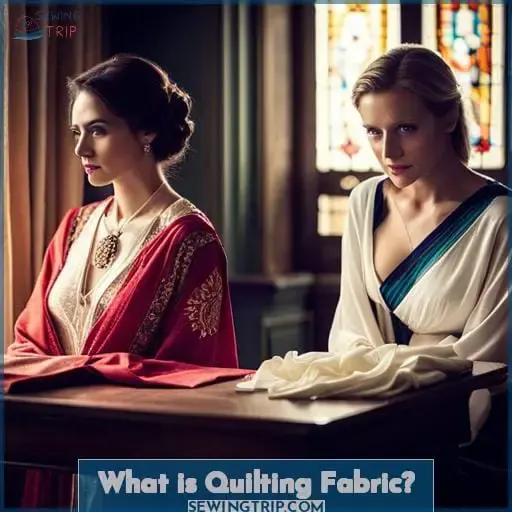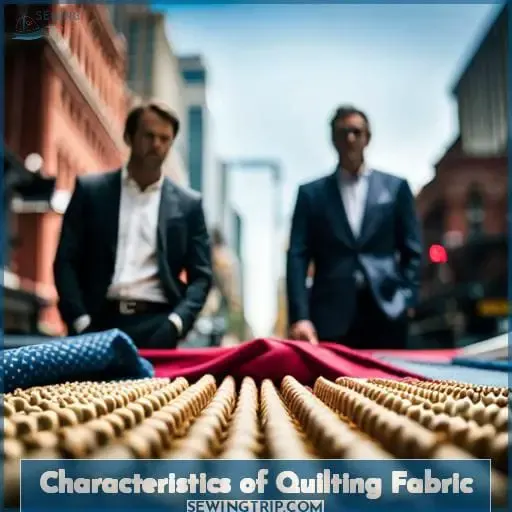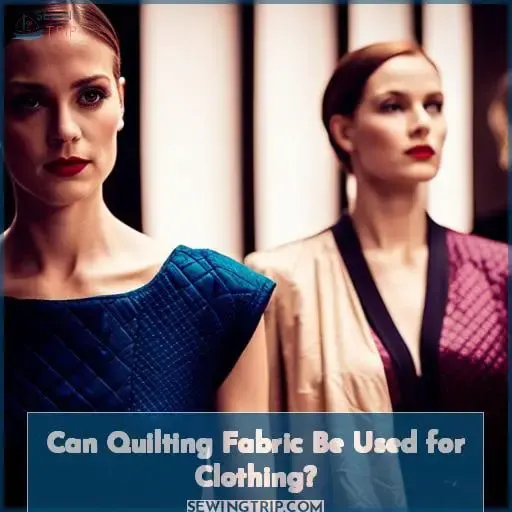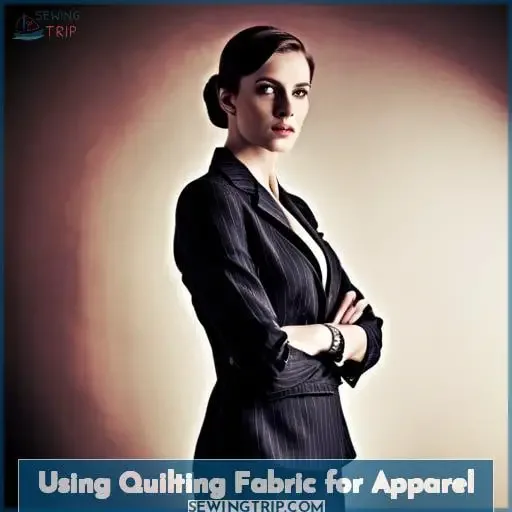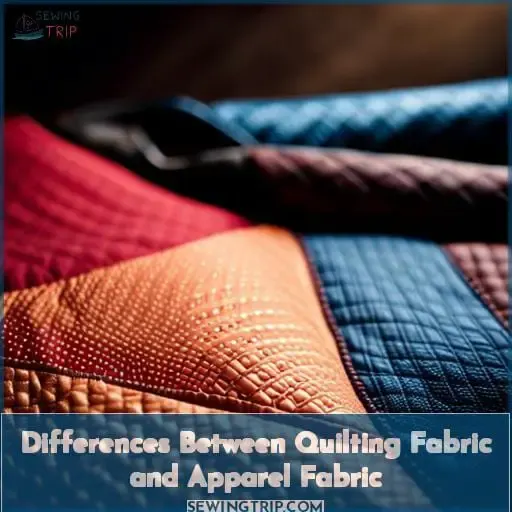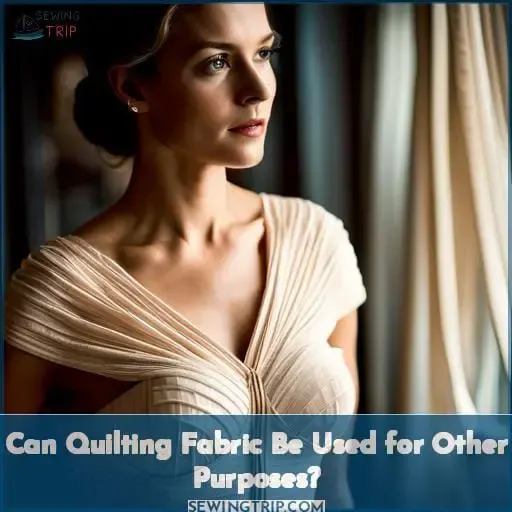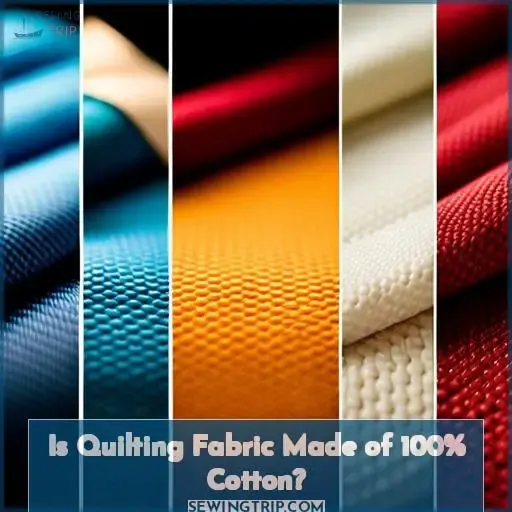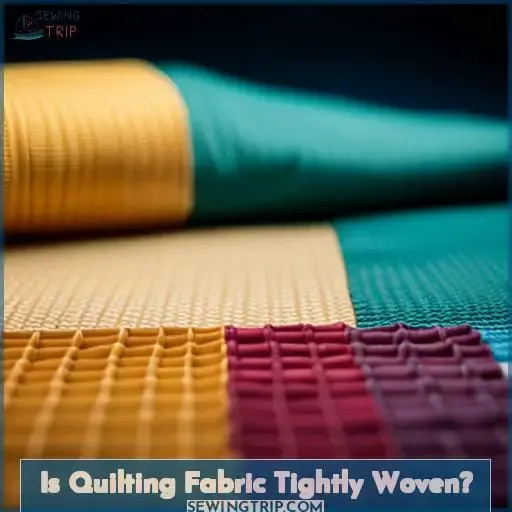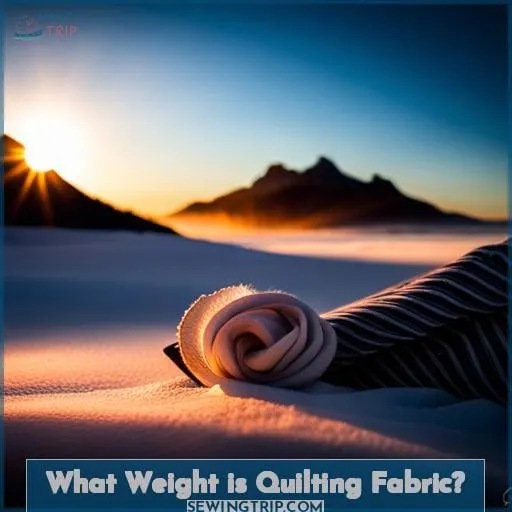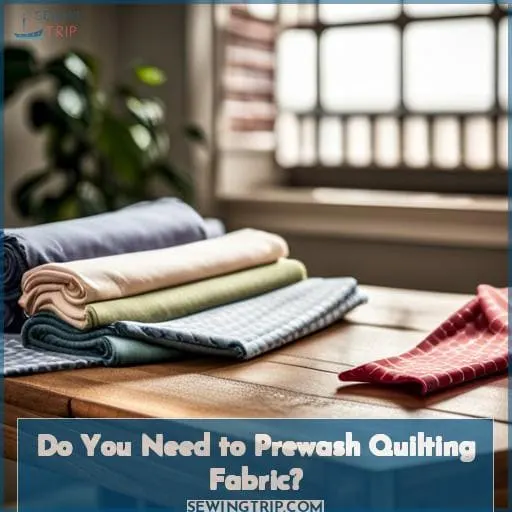This site is supported by our readers. We may earn a commission, at no cost to you, if you purchase through links.
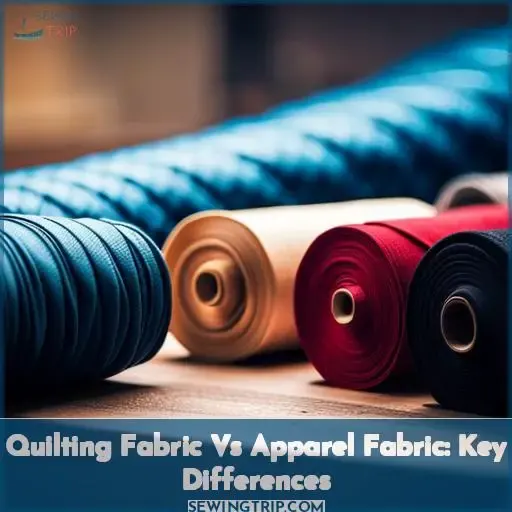 Ah, quilting fabric. It’s the stuff of legend – or at least a few household projects! But how does it differ from apparel fabric? And what are the key differences between these two fabrics when you’re deciding which to use for your next project?
Ah, quilting fabric. It’s the stuff of legend – or at least a few household projects! But how does it differ from apparel fabric? And what are the key differences between these two fabrics when you’re deciding which to use for your next project?
Well, if this is something you’d like to know more about, then read on! In this article, we’ll explore everything there is to know about quilting and apparel fabrics: their characteristics, can they be used interchangeably, and most importantly – all the differences that make them unique.
From weave texture, weight, and drape through stretch and comfort right down to style appearances – let’s get ready to discover what sets these two types of materials apart so that you can make an informed decision for your sewing needs.
Table Of Contents
- Key Takeaways
- What is Quilting Fabric?
- Characteristics of Quilting Fabric
- Can Quilting Fabric Be Used for Clothing?
- Using Quilting Fabric for Apparel
- Differences Between Quilting Fabric and Apparel Fabric
- Can Quilting Fabric Be Used for Other Purposes?
- Is Quilting Fabric Made of 100% Cotton?
- Is Quilting Fabric Tightly Woven?
- What Weight is Quilting Fabric?
- Do You Need to Prewash Quilting Fabric?
- Conclusion
Key Takeaways
- Quilting fabric is stiffer and more durable, while apparel fabric offers diverse textures and weaves for different styles.
- Quilting fabric is limited in stretch and may result in a homemade appearance in apparel, while apparel fabric provides different stretch levels for comfortable movement.
- Quilting fabric is suitable for quilts and structured garments, while apparel fabric is suitable for a variety of clothing styles.
- Quilting fabric may require prewashing to prevent shrinkage and color bleed, while proper pretreatment of apparel fabric is essential for sewing success.
What is Quilting Fabric?
Quiltin’ cotton is a sturdy, medium-weight fabric that’s perfect for beginner sewers lookin’ to make quilts or structured garments. It’s typically 100% cotton with a plain weave, so it’s prone to wrinklin’, but it can handle frequent washin.
The limited stretch from the plain weave makes it best for loose-fittin’ designs. Prewashing’s a must to prevent shrinkage and color bleedin’. Overall, it’s beginner-friendly, wrinkle-prone, and has limited stretch compared to apparel fabrics.
The sturdy medium-weight cotton is suitable for quilts, home dec items, children’s clothes, and structured garments, but the bulky homemade look may not work for more tailored pieces. Consider linin’ garments made with quiltin’ cotton if the base fabric’s too thick on its own.
Characteristics of Quilting Fabric
You’ll find it’s medium-weight and typically 100% cotton, with a plain weave that’s beginner-friendly yet prone to wrinkling.
Quilting fabric indeed has distinct characteristics that set it apart from apparel fabric. Here’s a closer look:
Characteristics of Quilting Fabric:
-
Stiffness: Quilting fabric is notably stiffer compared to apparel fabric, making it ideal for structured garments and, of course, quilting projects.
-
Durability: Its medium-weight nature renders it suitable for frequent washing, ensuring longevity in quilts and certain clothing items.
-
Limited Stretch: The plain weave in quilting fabric minimizes stretch, which can pose challenges when crafting fitted clothing. However, it excels in maintaining shape for quilt blocks.
In essence, quilting fabric stands out for its stiffness, durability, and limited stretch, making it a top choice for quilting endeavors but somewhat less versatile for apparel due to potential fitting issues.
Understanding these fabric properties is key to making informed decisions in your sewing projects.
Can Quilting Fabric Be Used for Clothing?
When considering your clothing projects, keep in mind that quilting cotton, while beginner-friendly and available in various colors and patterns, may not always provide the desired drape and comfort for your garments.
Quilting fabric is primarily designed for quilts and structured items, making it less ideal for clothing that requires flow and movement. Its stiff nature can result in a bulky, homemade appearance in apparel, lacking the graceful drape of dedicated fashion fabrics like cotton lawn, voile, or sateen.
While quilting fabric offers advantages in terms of easy sewing and an extensive range of designs, it’s essential to prioritize fabric quality and suitability for the intended garment. Experimentation can yield creative clothing with quilting fabric, but for garments that demand both style and comfort, exploring dedicated apparel fabrics with varying weights, drapes, and textures is recommended.
So, weigh your fabric selection carefully for the best outcome in your DIY fashion endeavors.
Using Quilting Fabric for Apparel
If you’re aiming to create stylish clothing pieces, choosing quilting fabric for garments can be a unique and creative choice. Quilting cotton offers a wide array of colorful patterns and designs that can add a touch of individuality to your fashion creations.
However, it’s essential to be aware of the pros and cons of using quilting fabric for apparel. Quilting fabric’s sturdy nature makes it ideal for structured garments like dresses and blouses with a defined silhouette.
Its medium weight ensures durability and frequent washing, making it a practical choice for everyday wear.
On the downside, quilting cotton can be prone to wrinkling, so it’s important to press your garments with a hot, steamed iron.
When sewing with quilting fabric, remember to pre-wash it to prevent shrinkage and color bleed. Select the appropriate needle size and thread type, and finish raw edges neatly. With the right styling and sewing techniques, you can turn quilting cotton into fashion-forward apparel that stands out with its unique charm.
Differences Between Quilting Fabric and Apparel Fabric
When choosing between quilting fabric and apparel fabric for your sewing projects, it’s essential to understand the key differences that can impact the outcome of your garment. We will explore the distinctions in terms of weave and texture, weight and drape, stretch and comfort, as well as appearance and style, helping you make informed decisions to achieve the desired look and feel in your creations.
Weave and Texture
Explore the intricate patterns and tactile qualities of various weaves and textures to elevate your sewing projects.
Texture Differences:
Quilting fabric often boasts a smoother, flat texture, suitable for intricate designs.
Apparel fabric, on the other hand, offers a diverse range of textures, from soft and silky to textured and ribbed.
Weave Variations:
Quilting fabric typically features a plain weave, while apparel fabric presents a spectrum of weaves like twill, satin, or crepe, each lending a unique character to your garments.
Fabric Selection:
Consider your project’s style and functionality when choosing between the simplicity of quilting fabric or the texture-rich options of apparel fabric.
Apparel Considerations:
Garment drape, comfort, and appearance hinge on the weave and texture of your chosen fabric. Make the right selection to achieve the desired result in your clothing creations.
Weight and Drape
To appreciate how fabrics vary in terms of weight and drape, you’ll find that some are lightweight and flow gracefully, while others are heavier and maintain a structured form. When it comes to apparel fabric selection, weight and drape are crucial factors.
Apparel fabrics offer a wide range of options, from the airy Cotton Lawn ideal for flowing dresses to the structured stiffness of Shirting fabric for tailored shirts. Quilting fabric, on the other hand, is limited in terms of weight and drape, making it more suitable for quilts than clothing.
Stretch and Comfort
Consider how much the fabric can stretch and how comfortable it feels against your skin, ensuring your sewing project will be a joy to wear.
-
Stretch vs. Comfort: Quilting fabric offers limited stretch due to its plain weave, making it less forgiving for body movement compared to the stretchy fabrics often used in apparel. Apparel fabric, on the other hand, comes in various stretch levels, allowing for ease of movement.
-
Fabric Selection: When deciding between quilting fabric and apparel fabric, think about the stretch requirements of your pattern. If it’s a snug fit, opt for apparel fabric with the right amount of stretch for comfort.
-
Apparel Suitability: For clothing comfort, apparel fabric is the go-to choice due to its diverse range of stretch options, ensuring your garments feel as good as they look.
Appearance and Style
When choosing between the two types of materials, your clothing will exude distinct vibes; the one crafted from cotton with a plain weave might give off a slightly bulkier and more homemade look, while the other, with its varied weaves and fibers, can offer a range of styles and appearances.
Apparel fabric opens the door to diverse fabric patterns, allowing you to express your unique fashion choices. Its visual appeal and aesthetic differences make it a versatile choice for creating garments that reflect your personal style.
Can Quilting Fabric Be Used for Other Purposes?
Certainly! Quilting fabric, with its durable and versatile nature, can be used for crafting curtains, upholstery, and cushions effectively.
Curtains
Transform your space into a mesmerizing haven with the incredible ability of quilting cotton to turn your curtains into a vivid, color-drenched masterpiece.
-
Vibrant Patterns: Quilting fabrics offer a wide array of colorful and eye-catching patterns that can instantly revamp your home decor.
-
Durability: Quilting cotton’s medium weight and ability to withstand frequent washing make it a practical choice for curtains that will last.
-
Customization: With quilting fabric, you can easily create curtains tailored to your style, from playful prints to elegant designs, adding a unique touch to your living space.
Upholstery
If you’re looking to give your old furniture a fresh new look, upholstery with the right material can completely transform your living space. Quilting cottons offer a budget-friendly option for upholstery projects with their durability, easy care, and wide range of prints.
When selecting fabric, consider the usage and traffic on your upholstery along with maintenance. Pre-wash and test samples before starting your project. With the right preparation, quilting cotton can lend itself to many upholstery applications, from slipcovers to ottomans, bringing new life and personality to your home.
Cushions
You could cover your sofas in mud flaps and mistakenly think the abundance of studs brings sophistication. Quilting cotton provides a thicker, more durable alternative to apparel fabrics for cushion covers.
Its tightly woven fabric resists pilling and fading but requires more frequent laundering than fabrics treated for heavy home use. Consider linen blends, performance woven fabrics, and microsuede for cushions subjected to heavier wear.
Is Quilting Fabric Made of 100% Cotton?
Though often made from 100% cotton, quilting fabric comes in a variety of fiber blends for unique drapes, textures, and performance.
When considering whether quilting fabric can be used for other purposes, it’s essential to understand that quilting fabric primarily caters to the quilting world. However, its 100% cotton composition grants it a few advantages when utilized for apparel.
- Natural Woven Fibers: Quilting fabric, being predominantly cotton, offers breathability and comfort, making it suitable for clothing.
- Fabric Comfort: Its softness and natural feel enhance comfort when used in garments.
- Versatility: While not the first choice for clothing, it can be used for casual, loose-fitting attire like dresses, blouses, or loungewear.
- Budget-Friendly: Quilting cotton often comes at a lower price point compared to specialized apparel fabrics, making it an economical choice for beginners.
So, yes, quilting fabric is typically made of 100% cotton, but it can find a place in your apparel projects, especially if comfort and affordability are paramount.
Is Quilting Fabric Tightly Woven?
In the world of sewing, fabric selection is paramount, and understanding the differences between quilting fabric and apparel fabric can make or break your project.
You may wonder, Is quilting fabric tightly woven? Well, the answer lies in its plain weave construction. Quilting fabric typically features a plain weave, which means the threads run in a simple over-under pattern, creating a tightly woven fabric.
This tightness is what gives quilting fabric its durability, making it suitable for frequent washing and handling.
To further assist you in your fabric selection journey, let’s compare quilting fabric and apparel fabric options in a handy table:
| Aspect | Quilting Fabric | Apparel Fabric |
|---|---|---|
| Fabric Weave Types | Plain weave | Various weaves and fibers |
| Fabric Weight | Medium-weight | Different weights, drapes, and stiffness |
| Suitable for Sewing | Beginner-friendly | Considerations for fabric quality and drape |
| Prone to wrinkling | ||
| Limited stretch |
Understanding the tightness and plain weave of quilting fabric is just the beginning of your fabric journey. Next, we’ll delve into the intricacies of choosing the right fabric weight for your sewing projects.
What Weight is Quilting Fabric?
When choosing between various types of cotton for your sewing projects, it’s important to consider the weight of the material. Quilting fabric is typically of a medium weight, making it suitable for quilts and structured garments.
This weight provides stability and durability for stitching layers together in quilting.
However, when it comes to apparel, the weight of quilting fabric can be a drawback. Its stiffness and lack of drape may result in garments that appear bulky and homemade. In contrast, apparel fabric comes in a wide range of weights, offering more versatility for different clothing styles.
Lighter options like cotton lawn and voile are perfect for flowy blouses and summer dresses, while heavier fabrics like denim or wool can be used for pants and coats. The choice of weight affects the fabric’s drape and overall quality in clothing, allowing you to create garments with a professional finish.
Additionally, prewashing fabric is crucial, especially for apparel, to prevent shrinkage and maintain the desired weight and drape in your finished piece. So, consider the weight of your fabric carefully when deciding between quilting and apparel fabrics for your sewing projects.
Do You Need to Prewash Quilting Fabric?
You’ll wanna prewash your quilting cotton before cutting and sewing. Quilting fabric is prone to shrinkage and fading, so prewashing is highly recommended.
Immerse the fabric in lukewarm water with a gentle detergent, using the delicate cycle. Repeat with a second rinse to fully remove excess dye and sizing. This pre-shrinks the fabric and helps prevent size changes once your garment is complete.
Give the wet fabric a hard press to preshrink it further. Then lay flat to dry to prevent distortion.
Always check fabric markings post-washing since they may bleed. Properly pretreating quilting cotton is an essential first step for a successful sewing project. With a bit of care upfront, you’ll have crisp, colorfast fabric ready for cutting and sewing.
Conclusion
It’s estimated that quilting cotton accounts for more than half of all cotton fabric sold in the United States. With its versatility and strong cotton composition, quilting fabric is a great choice for many projects.
However, it’s important to understand the key differences between quilting and apparel fabric when choosing the right textile for a project. Quilting fabric typically has a plain weave and is less stretchy, making it best for quilting and structured garments.
Apparel fabric, on the other hand, has various weaves and fibers, and is usually a heavier weight. It has considerations for fabric quality and drape, making it ideal for clothing.
Understanding these differences will help you pick the best fabric for your project.

